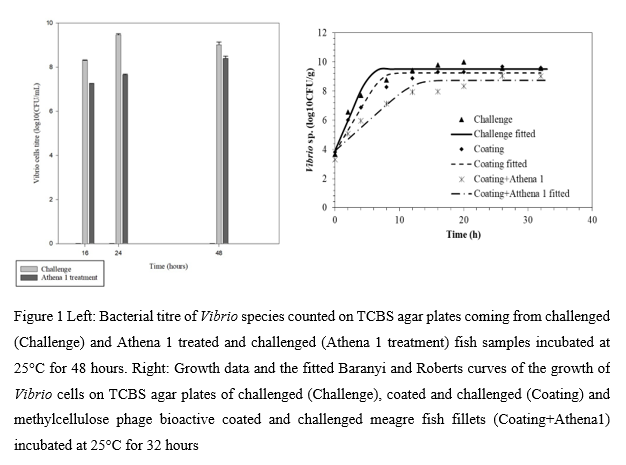MITIGATION OF POST-HARVEST CONTAMINATION IN FISH BY A METHYL-CELLULOSE COATING INCORPORATING BACTERIOPHAGES TARGETING Vibrio alginolyticus
Introduction
Post- harvest contamination poses a significant challenge in aquaculture, directly affecting the microbiological quality and shelf life of fish products. Vibrio alginolyticus is among the predominant microorganisms in marine fish. In the pursuit of sustainable and targeted antimicrobial interventions , bacteriophages have emerged as promising biocontrol agents. This study investigates the application of the lytic bacteriophage Athena 1, incorporated into a methyl- cellulose-based edible coating, for the control V. alginolyticus V1 on fresh fish. The investigation focuses on assessing the phage’s stability, lytic efficacy, and antimicrobial efficacy within the coating matrix under conditions that simulate post-capture handling and storage.
Materials and Methods
The lytic bacteriophage Athena 1, specific to Vibrio alginolyticus strain V1, was evaluated for its stability across a range of pH values and temperatures to confirm its viability during coating preparation. Subsequently , Athena 1 was directly applied to surface-contaminated Argyrosomus regius fillets to evaluate its standalone antimicrobial activity. A phage bioactive coating (PBC) was formulated by incorporating Athena 1 (~10⁹ PFU/mL) into a 2% (w/v) methyl- cellulose solution. The coating was applied to fish fillets by immersion, and its in vivo efficacy against V. alginolyticus was evaluated over a 48-hour incubation at 25°C. Microbiological analysis included enumeration of Total Viable Counts and Vibrio spp., while phage persistence was monitored through plaque assays and absolute quantification via RT-qPCR. Furthermore , a predictive growth model was employed to estimate the kinetic parameters of V. alginolyticus under each treatment, providing a deeper understanding of the inhibitory effects of the coating and the growth dynamics of the target bacterium on fish fillets.
Results
Athena 1 exhibited strong lytic activity under the condition required for coating preparation , demonstrating its stability and robustness. Direct application of the phage onto fish fillets resulted in a significant reduction of Vibrio alginolyticus V1 growth compared to untreated controls, indicating effective antimicrobial activity even withing the complex matrix of fish tissue (Figure 1).
The in vivo application of the phage incorporated into a methyl-cellulose-based bioactive coating (PBC) effectively delayed b acterial growth by 1.68 log₁₀ CFU/mL, supporting previous findings . To further validate its performance, an accelerated shelf-life study was conducted. T he growth rate of V. alginolyticus V1 was significantly lower in the PBC-treated group (0.395 ± 0.0791) compared to the coating without phage (0.748 ± 0.0973) and the untreated control (1.026 ± 0.163) (Figure 1). Additionally , absolute quantification of bacteriophage Athena1 during the accelerated shelf-life study demonstrated a time-dependent increase in phage levels following coating application. A statistically significant exponential rise (approximately 104-fold ) in PFU levels was observed within the first 8 hours post-application, followed by a plateau phase that persisted for at least 16 hours.
These findings highlight the potential of Athena 1 as an effective antimicrobial agent within methyl- cellulose-based biodegradable coatings for fish, further supporting the promising role of bacteriophages in mitigating spoilage and extending the shelf life of aquaculture products.
